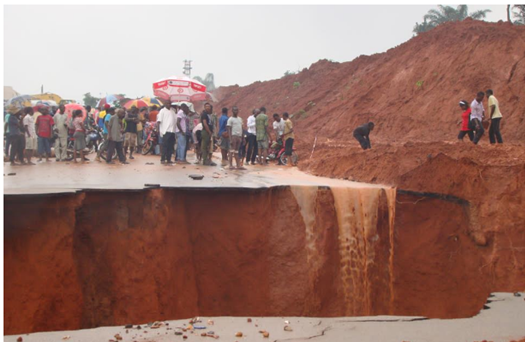In Sub-Saharan Africa, countries are faced with environmental degradation. The results of the constantly changing climate in this region are often impactful, ranging from draught to desertification and even soil erosion. In Nigeria, Igboland is the hardest hit.
The type of erosion that is most commonplace is full erosion which creates bottomless gullies across the region, threatening agricultural productivity, transportation, and the common existence of countless people.
For this, the problem of soil erosion in the South-East has become a subject of interest to soil scientists, geologists, geographers, and the sort. In the region, there are several locations that have been ravished by gullies, dissecting the landscape into menacing landslides.
According to reports, Eastern Nigeria has lost more than a substantial amount of its land to erosions – farmlands, roads, highways, residential areas, all eaten up by gullies. In Anambra State alone, there are hundreds of active erosion sites.
In looking at these five, we are not saying they are the most dangerous sites or the most prominent by whatever parameter. What we did was point out a big problem in the southeast and give examples, randomly even.
Ifite Nanka Gully, Anambra State
Ifite Nanka gully site is almost 200 years old.
According to researchers, gully erosion began in Ifite Nanka, a town in Orumba North LGA of Anambra State, as far back as 1850, and over the years, has grown to a depth of 66 metres, a length of 2,900 metres and a width of 349 metres, making it one of the largest gully sites in Nigeria.

Several acres of farmland in the Nanka area is gradually being eaten up the erosion, resulting in significantly reduced food production in the area. Nanka is full of aggrieved farmers who keep bemoaning the relentless washing away of the soil fertility of their farmlands. Residential buildings in the town are not safe either as the gully keeps on growing at an alarming rate, taking down everything in its path.
Ihioma Gully, Imo State
The grip of the gully erosion on landscapes in Imo State has been described as an iron-clad catastrophe as several desperate appeals have been made to the government by the locals in the area who live daily in fear as to the damage happening all around them.
The erosion sites that litter Ideato North and South LGAs and stretch up to Orlu are to the tune of over 200, and several highways have bowed to the vicious rampage of landslides, disconnecting natives in the area from the rest of Imo State.
Ihioma Gully in Orlu, which is about 4 kilometers in length, extends to more than ten villages and has since been cutting off these villages from engaging in their inter-communal activities.
Read this – How these major Igbo cites got their names
Rainy season is a terrific time to worsen the gully site at Oguduasaa, Isuikwuato.
With every rainy season comes even more ruthlessness from the gully erosion that has besieged Oguduasaa and Uturu communities in Isuikwuato, Abia State. Several federal roads have collapsed under the activity of the expansive gully erosion. Several residents have abandoned their homes as the gully continues to gain more ground in the inhabitable spaces in the community. It keeps on developing with an undisguised threat to lives and properties.

What makes the gully site at Oguduasaa particularly unique in the danger it poses to the residents is the fact that there have been several reports of hoodlums and armed robbers who have found the gully site to be a perfect rendezvous from which they can perpetuate their numerous vices, endangering several lives.
Oguduasaa Gully, Abia State
One of the gully’s infamous contributions to the town was the collapse of the Isuikwuato-Uturu Road in 2000. Following that collapse, the residents of the area have had to take diversions through bush paths to get to their destinations ever since then.

The Oguduasaa Gully site has become a literal den of vicious thieves.
Amucha Gully, Imo State
The monstrous gully at Amucha is reputed to have eaten up an entire clan, the Amucha Ohonnya, a community that stretches to about 6km in Njaba LGA of Imo State.
The devastation the fully left of the community has inspired a lot of speculations amongst residents in the area that it could just be that the gully is an aftermath of the mass abandonment of the worship of Eke Njaba (Python Mythology) fetish for the Christian faith. Yes, it is that bad for the community.
Amucha Gully site is so devastating that locals in the area have described it as the wrath of a neglected deity.
While it is easy to give in to sentimentality, the fact remains that Amucha Ohonnya is a sloping area of land, which makes it vulnerable to vicious deterioration after heavy rainfall. Hence, the gully is not a new, mysterious event in the community.

In the past, the community has always kept the erosion in check with sustainable farming practices until the late ’60s, during the heat of the civil war. Neglected for some years, the gully became a calamity that grew with ferocious speed.
Agulu Gully, Anambra State
Agulu Gully site is a few kilometers away from Nanka and is just as abysmal.
Agulu community is currently being wrecked by gully erosion, with several farmlands, which natives call
Uhana (land for cultivation), getting destroyed in the process. In the past, the land in Agulu was arable enough for cassava and cocoyam plantation until uncontrolled heavy rainfall and flooding began to turn it into a gully site.

Several farmers in the area have been dispossessed of their source of livelihood as the erosion continues to develop. There have also been reports of residents who fell into the deep manhole created by the gully and never made it out alive. It is quite a dangerous area to live in.
By Johnson Onyedika
Connect with us on LinkedIn

